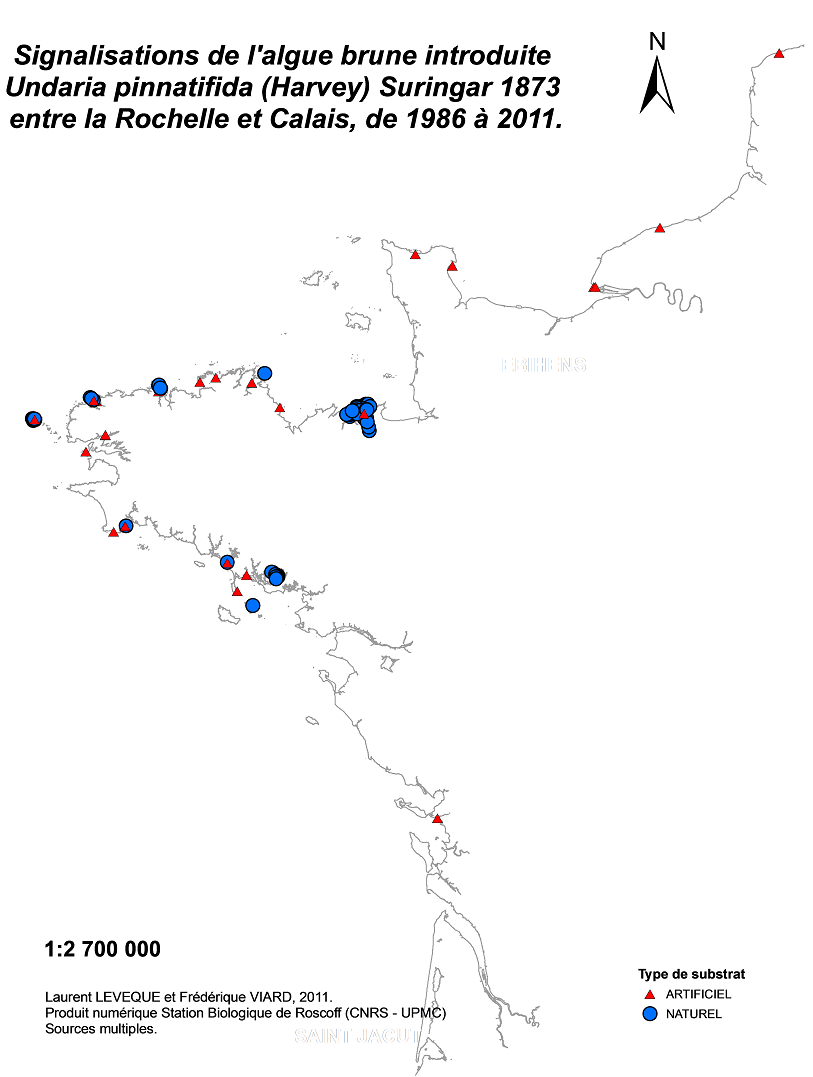Distribution et dynamique d’installation d’Undaria pinnatifida, une algue non-indigène en Bretagne (Programmes Ecokelp ANR
2007-2009 et Interreg IVA Marinexus 2010-2014)
Distribution and installation dynamics of Undaria pinnatifida, a non-indigenous species of algae in Brittany (Ecokelp ANR
2007-2009 and Interreg IVA Marinexus Programmes 2010-2014)
Undaria pinnatifida, connue sous le nom de wakame, une macro-algue brune a été introduite de façon délibérée en Bretagne pour y être cultivée et s’est échappée dans le milieu naturel depuis la fin des années 1980. Deux programmes, Ecokelp (2007-2009) et Marinexus (2010-2014) se sont intéressés à la dynamique de la distribution spatiale de cette algue non-indigène en Bretagne. ECOKELP visait à une meilleure compréhension de la dynamique des forêts de macro-algues brunes et Undaria pinnatifida était une des 5 espèces cibles de ce projet. MARINEXUS avait pour objectif d’étudier les écosytèmes marins à l’échelle trans-Manche et un « workpackage » était consacré aux espèces non-indigènes, parmi lesquelles figuraient U. pinnatifida. Ces deux projets visaient entre autre à faire un état des lieux de la présence d’Undaria pinnatifida le long du littoral breton dans des habitats artificiels (ports, marinas) et naturels, en réalisant des prospections et des comparaisons aux données de la littérature. Un focus a été en particulier réalisé dans la rade de St-Malo, la baie de Lampaul (Ouessant), l’Aber Wrac’h et la baie de Morlaix. Observations, cartographie à micro-échelle, analyses génétiques ont été réalisés au cours de ces programmes.
Une thèse (Daphné Grulois – UPMC ; dir. F. Viard – Station Biologique de Roscoff; contact : viard@sb-roscoff.fr) rassemble l’essentiel des données d’observations, inventaires et cartographies réalisées jusqu’à la fin du programme Ecokelp. Elle est disponible à l’adresse : http://www.sb-roscoff.fr/images/stories/sbr/Edition-communication/theses/Grulois_thesis.pdf
Undaria pinnatifida, brown micro-algae also known as wakame, was deliberately introduced in Brittany to be grown as a crop, and started to grow wild at the end of the 1980s. Two programmes, Ecokelp (2007-2009) and Marinexus (2010-2014) focus on the dynamics of the distribution of this algae which is not native to Brittany. ECOKELP aimed to better understand the dynamics of micro-algae forests, and Undaria pinnatifida was one of the project’s target species. MARINEXUS aimed to study marine ecosystems trans-channel, and a “workpackage” was dedicated to non-indigenous species, including Undaria pinnatifida. Both of these projects aimed to create an inventory of the presence of Undaria pinnatifida in artificial habitats (ports, marinas, etc.) and natural settings along the Breton coast, by surveying and then comparing data with the literature. Specific focus was on the bay around Mont Saint-Michel, Lampaul (Ushant), l’Aber Wrac’h and Morlaix bay. Observations, micro-mapping, and genetic analyses were conducted during the programmes. A PhD thesis (Daphné Grulois – UPMC ; dir. F. Viard – Station Biologique de Roscoff; contact : viard@sb-roscoff.fr) brings together and summarises the data, observations, inventories and maps created throughout the Ecokelp programme. It is available at: http://www.sb-roscoff.fr/images/stories/sbr/Edition- communication/theses/Grulois_thesis.pdf



)))